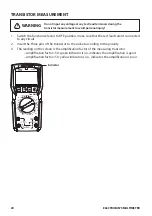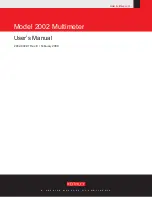
5
OPERATING MANUAL
•
Connect the common test lead before the live test lead and remove the live test lead
before the common test lead.
•
Do not use a current measurement as an indication that a circuit is safe to touch. A voltage
measurement is necessary to know if a circuit is hazardous.
•
Do not use the HOLD function to measure unknown potentials. When HOLD is turned on,
the display does not change when a different potential is measured.
•
When using the test leads, ensure leads are fully seated and keep your fingers behind the
finger guards.
•
To avoid electric shock, injury, or damage to the meter, disconnect circuit power and
discharge all high-voltage capacitors before testing resistance, continuity, diodes, or
capacitance.
•
Before measuring current, check the meters fuses’ and turn off the current to be tested
before connecting the meter to the circuit. After connecting the circuit reliably, turn the
current to be tested on.
•
Replace the battery as soon as the battery indicator “
” appears. With a low battery,
the meter may produce false readings that can lead to electric shock and personal injury.
•
Do not alter the meter and use only as specified, or the protection supplied by the meter
can be compromised.
•
Use a soft cloth and mild detergent should to clean the surface of the meter when
performing general maintenance. No abrasives or solvents should be used in cleaning;
this is to prevent the surface of the meter from corrosion, damage and accident.
•
Turn the meter off when it is not in use. Remove the batteries if the meter is not used for
an extended period of time. If the batteries are not removed, battery leakage may result.
•
Repair the meter before use if the battery leaks. Battery leakage may create a shock hazard
or damage the meter.






































